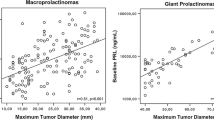Abstract
Hyperprolactinaemia frequently causes secondary hypogonadism through central suppression of gonadotropin secretion. Macroprolactinomas (>1 cm diameter) are more common in males and may additionally cause more generalised hypopituitarism. Recovery of the thyrotropic and/or corticotropic axes is well described following selective adenomectomy, but remains poorly defined in relation to medical (dopamine-agonist) therapy of macroprolactinomas. We therefore performed a retrospective examination of case records of male patients who had received medical therapy alone for macroprolactinoma between 1980–2001 (n = 35) and in whom tumor shrinkage was documented by interval pituitary imaging (reported throughout by a single neuroradiologist).
Mean prolactin level at baseline was 59,932 mU/L (median 31,400; range 3,215–332,000); mean period of follow up was 4.2 years (median 2.6; range: 1.0–15). Defects of the following axes were evident at diagnosis: LH/FSH-testosterone (n = 27; 77%), TSH-T4 (n = 14; 41%-not including one case with pre-existing 1° hypothyroidism), ACTH-cortisol (n = 8; 23%). Overall, 14 men (40%) were deficient in 1 axis, seven (20%) in 2 axes and seven (20%) in 3 axes. Growth hormone secretory status was not systematically evaluated. In all but 6 patients, prolactin levels fell to normal or near-normal levels (mean 764 mU/L; median 260; range: <10–4,833). Of the patients in whom adequate reassessment had been performed, thyrotroph function recovered in 4/9, corticotroph function in 4/6 and gonadotroph function in 16/26 cases. In four cases (11%) previously described, development of visual impairment as a result of the chiasmal traction syndrome necessitated a dose reduction in medical therapy to allow a degree of controlled tumor re-expansion.
The prevalence at diagnosis of TSH and ACTH deficiency in men with macroprolactinomas was 41% and 23%, respectively. Among eight patients with insufficiency of TSH and/or ACTH secretion who underwent complete interval reassessment over several years of treatment, recovery of at least one axis occurred in six cases (75%). This study highlights the importance of screening ACTH- and/or TSH-deficient men during dopamine agonist therapy in order to identify cases where hypopituitarism has resolved.
Similar content being viewed by others
References
Pinzone JJ, Katznelson L, Danila DC, Pauler DK, Miller CS, Klibanski A. Primary medical therapy of micro-and macroprolactinomas in men. J Clin Endocrinol Metab 2000;85:3053–3057.
Mbanya JCN, Mendelow AD, Crawford PJ, Kendall-Taylor P. Rapid resolution of visual field abnormalities with medical therapy alone in large macroprolactinomas. Br J Neurosurg 1993;7:519–527.
De Rosa M, Colao A, Di Sarno A, Ferone D, Landi ML, Zarrilli S, Paesano L, Merola BR, Lombardi G. Cabergoline treatment rapidly improves gonadal function in hyperprolactinaemic males: A comparison with bromocriptine. Eur J Endocrinol 1998;138:288–293.
Prescott RWG, Johnston DG, Kendall-Taylor P, Crombie A, Hall K, McGregor A, Hall R. Hyperprolactinaemia in men-response to bromocriptine therapy. Lancet 1982;1(8266): 245–248.
Wass JA, Williams J, Charlesworth M, Kingsley DPE, Halliday AM, Doniach I, Rees LH, McDonald WI, Besser GM. Bromocriptine in management of large pituitary tumours. BMJ 1982;284:1908–1911.
George LD, Nicolau N, Scanlon MF, Davies JS. Recovery of growth hormone secretion following cabergoline treatment of macroprolactinomas. Clin Endocrinol 2000;53:595–599.
Hurel SJ, Thompson CJ, Watson MJ, Harris MM, Baylis PH, Kendall-Taylor P. The short synacthen and insulin stress tests in the assessment of the hypothalamic-pituitary-adrenal axis. Clin Endocrinol 1996; 44:141–146.
Jones SE, James RA, Hall K, Kendall-Taylor P. Optical chiasmal herniation-an under-recognised complication of dopamine agonist therapy for prolactinoma. Clin Endocrinol 2000;53:529–534.
Author information
Authors and Affiliations
Corresponding author
Rights and permissions
About this article
Cite this article
Sibal, L., Ugwu, P., Kendall-Taylor, P. et al. Medical Therapy of Macroprolactinomas in Males: I. Prevalence of Hypopituitarism at Diagnosis. II. Proportion of Cases Exhibiting Recovery of Pituitary Function. Pituitary 5, 243–246 (2002). https://doi.org/10.1023/A:1025377816769
Issue Date:
DOI: https://doi.org/10.1023/A:1025377816769




